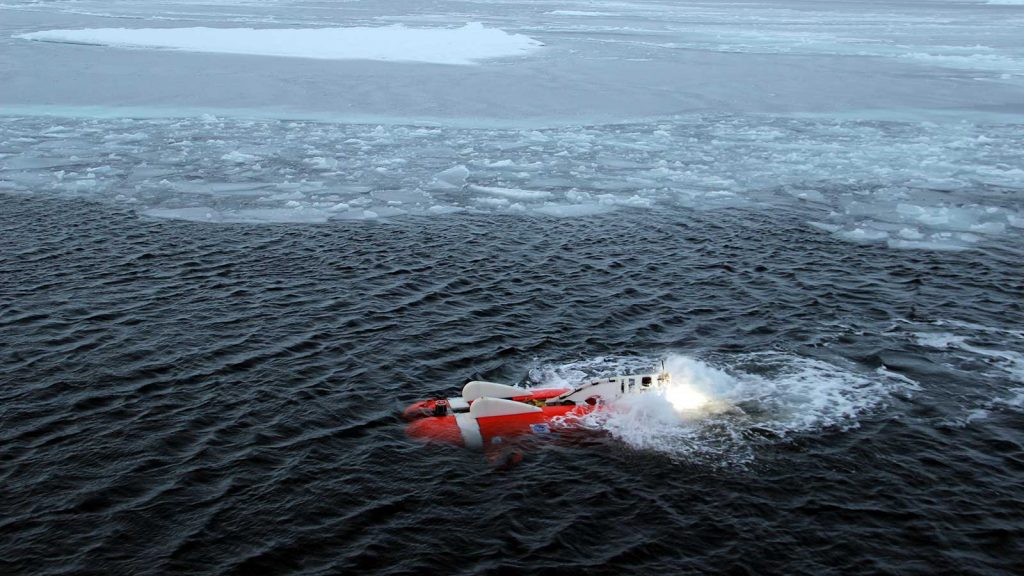
NUI returns to the surface after a new record descent to 350m in the Arctic Ocean during engineering trials on September 20, 2016. It was much warmer in the ocean than it was out on deck! (photo by Chris German, Woods Hole Oceanographic Institution)
NUI tried to misbehave today (Tuesday), but Mike took it out on deck and gave it a stern talking-to and eventually we ended the day friends. That’s the short version.
At 6:30 a.m., the NUI team turned to and started work on the 3.5-hour pre-dive preparations that lead up to a successful NUI launch. Our plan was to start at 10:00 a.m. In fact, by the time the previous science operation finished and we had moved the ship to where we wanted to be for our work it was already 11:00 and by then NUI was already acting up. Specifically, it wasn’t talking to us nicely through all the fiber optic connections that we will rely on when we are using it as a remotely operated vehicle later in the cruise. What to do?
We came up with a series of tests to figure out how to improve things (in many complicated engineering ways that I am not intelligent enough to understand, let alone begin to explain). Then we took a break for lunch before the team got back to work diagnosing and testing as fast as they possibly could while I negotiated with our Chief Scientist, Antje, to move up some other elements of the day’s research program so that we could try again at either 2:00 or 4:00 p.m. for our engineering tests.
Two o’clock came and went and it was time for the next operation to begin, but at around 2:30 p.m., things fell into place. The NUI team hadn’t solved ALL the problems we were having, but they had worked out a really elegant way to bypass enough of them to still salvage something from the day. That included all the essential tests we needed to complete so that we could stay on schedule for the first science dives later in the week and for which I have been waiting *very* patiently (ahem!).
At 4:00, thanks to the Captain’s indulgence and with four hours of working time available during which we could get the help of all the ship’s crew who we needed to help get NUI in and out of the water safely and who had been standing by all day on our behalf, it was finally time to go.
I really felt the benefit of my insulated Mustang suit once it was “show time” because it was around -5°C (23°F) out on deck and where Andrew and I were stationed during the launch sequence one level up from the main deck was rather exposed. We were there to keep an eye out for any fast-moving ice that might approach from that side of the ship and that would cause a hazard for launching NUI, so we couldn’t hide out of the wind.
What was supposed to be a quick transition from NUI being on deck to in the water to below the surface took a while longer than expected. It wasn’t surprising, given that this was our first deployment of the expedition and eventually, at 6:15 p.m., NUI submerged and began to dive. Fortunately, it was also time to head inside and warm up as Kevin and Louis took over ice watch from us.
In the “control room” I watched the computer screens and camera feeds as NUI submerged to 70 meters (230 feet) depth and then continued down to 350 meters (1,150 feet). In 2014, we spent all our time studying the underside of the ice and never went deeper than about 30 meters (100 feet) and, at the 70-meter mark, I heard our pilot, Casey, point out that we were now more than twice as deep as NUI has ever been in the Arctic.
So as we continued down and all seemed relatively calm, I persuaded her to hand me the controls for about 30 seconds so that I got the chance to drive NUI even deeper. I didn’t keep going for long before handing the controls back, but what will now forever be true is that, for one half a minute, I was the World’s Deepest Diving ROV Pilot in the Arctic Ocean. Ever.
But now back to serious business. Just one hour after NUI began its descent, it was back on the surface again and by 8:00 p.m. it was back on deck. It was a very long day, but ultimately, thanks to the team’s perseverance and ability to diagnose problems and innovate fixes on the fly, it was also a very successful day. In particular, I was able to collect data on all my plume- and vent-hunting sensors during the descent and ascent and they are good to go! So now we are ready for the second NUI dive of the cruise and the thirteenth in the life of the vehicle.
Thirteen. Good grief! I’m glad my lucky charms aren’t superstitious.

